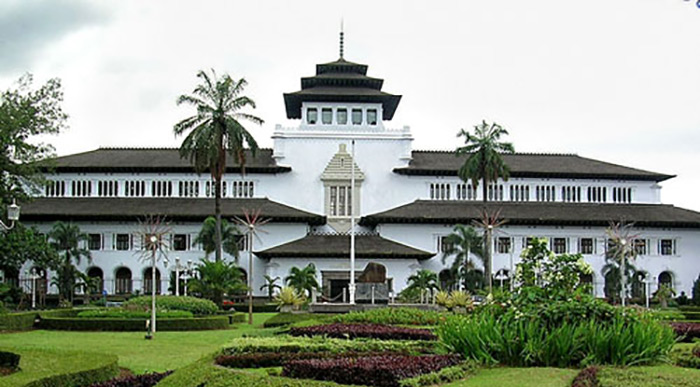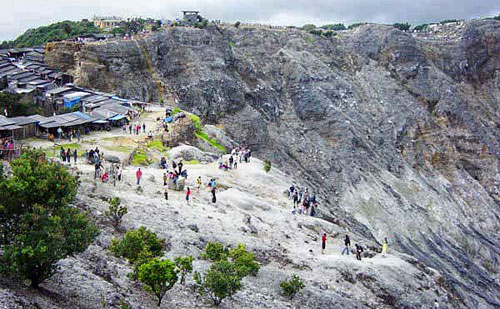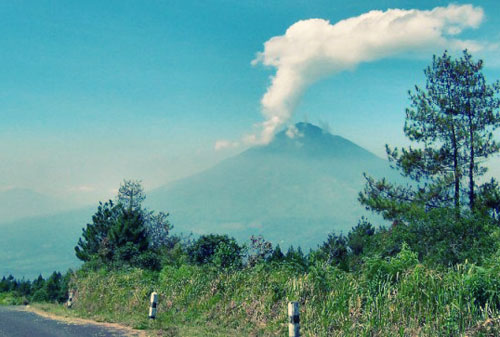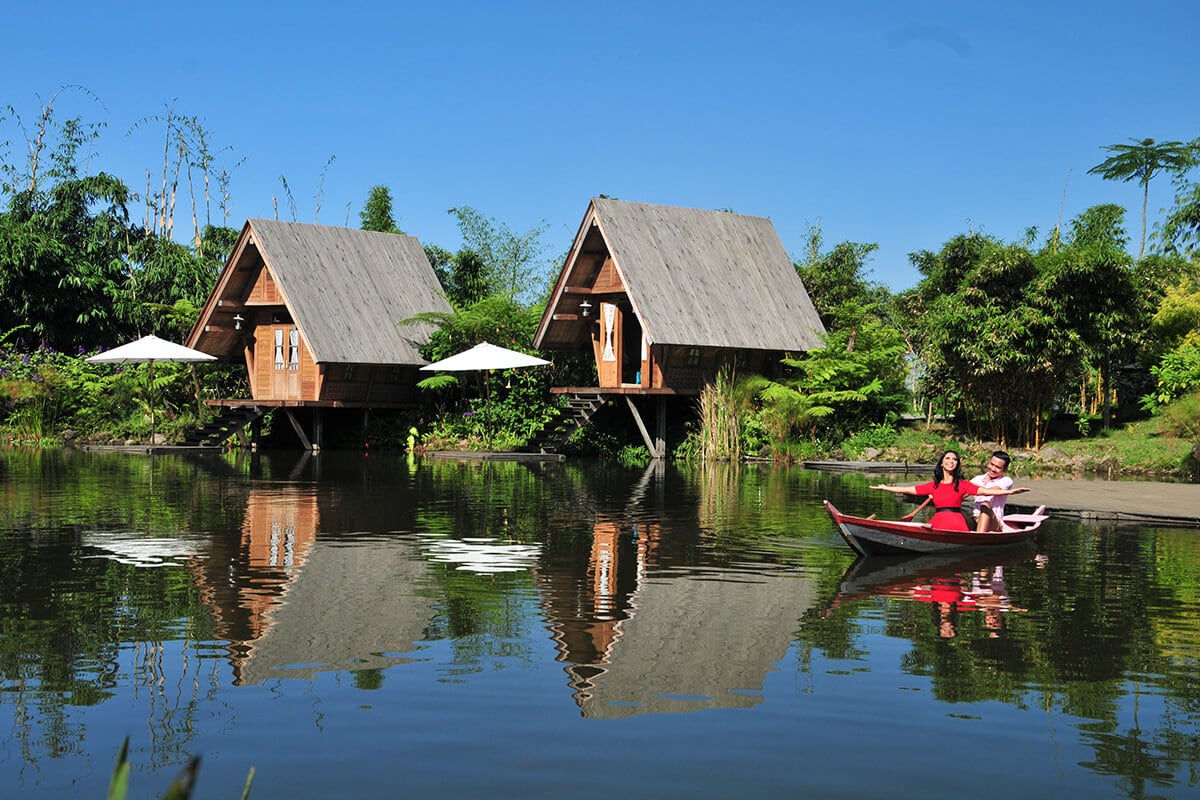The highland city of Bandung is only a short 2.5 hours' drive southeast of Jakarta via toll road, and is the overwhelming destination of choice for Jakarta residents to get away for weekends and long holidays. Lately it has also become a favorite holiday resort for tourists from Singapore and Malaysia, who come here in droves to shop and enjoy its nature and fabulous foods. And with its popularity, an abundance of hotels have sprouted offering business facilities to luxurious service or also budget rooms, and eateries galore serving yummy local dishes to old-style Dutch cuisine. Meanwhile, the adjacent cool town of Lembang and other scenic areas now also offer a wide variety of attractions and entertainment for the whole family, a haven for instagrammers.
Bandung is the capital of West Java in Indonesia. Bandung is 180 kilometers southeast from Jakarta. Although it has a population of over two million the pace of city life is slower than Jakarta's. Today Bandung has a population of 2 million people, Bandung area an estimated 4 million. Bandung is situated on a plateau 768 meters above sea level with a cool climate throughout the year. Bandung is the most European city of Java. The raining season starts in Bandung a little bit earlier, then the rest of Indonesia. Normally the raining season in Indonesia is from October till May, the peak of the raining season is in January. The dry season is from June until August, temperature is then 25-30 degrees Celsius during the day. In the morning, the sun is almost shining every day, but in the afternoon many times it gets cloudy, for sunbathing we have to wake up early from 6.30 the sun is already there. In the evening when the sun is down the temperature has drops. The average temperature in Bandung is 22 degrees Celsius; the weather is pleasant all year round.
There are short drives up to the mountain resorts of Lembang and the Bosscha Observatory, and higher to the volcanic crater of Tangkuban Perahu, the only crater in Java accessible all the way by car as far as its rim. It is an awe-inspiring sight of emanating sulfur fumes. Descent into all the volcano's 12 craters is only possible with the aid of an experienced guide, because of the presence of suffocating gases at certain spots. Just a 15 minutes drive from Tangkuban Perahu is a hot springs resort. Here we can swim in warm mineral water pools, good for healing skin problems. The resort provides visitors with a bar, restaurants, tennis courts and cottage style hotels overlooking a beautiful mountain-scope.
In Bandung, try to see the "Wayang Golek" wooden puppet show and hear the "Angklung" bamboo orchestra, as well as the classical Sundanese gamelan and dances. Several institutes of higher education are located here, including the country's prestigious Bandung Institute of Technology.
HISTORY
In 1488, the area now named Bandung was the capital of the Kingdom of Pajajaran. During colonial times, the government of the Dutch East Indies built a supply road connecting Batavia (now Jakarta), Bogor, Cianjur, Bandung, Sumedang and Cirebon. This event was very important for the growth of Bandung. In the 1930s the Dutch East Indies government planned for Bandung to become the capital of the Dutch East Indies due to its location, however World War II disrupted these plans.
It is not known exactly when Bandung city was built. However, contrary to the beliefs of some the city was not originally built by the orders of Daendels, the Dutch East Indies Governor General, but by the orders of 'Bupati' R.A. Wiranatakusumah II. The Dutch colonial powers built wide tree-lined boulevards, villas, gardens, and fountains, earning Bandung the nickname of "Parijs van Java", the Paris of Java, in the early 20th century. Many of these structures survive to today, and can be seen along the road leading to the Dago area north of the city.
After Indonesian independence, Bandung was named as the provincial capital of West Java. Bandung was the site of the Bandung Conference which met April 18-April 24, 1955 with the aim of promoting economic and cultural cooperation among the African and Asian countries, and to counter the threat of colonialism or neocolonialism by the United States, the Soviet Union, or other imperialistic nations.
Where Two Continents Meet
Worlwide, Bandung is better known today for its historic Bandung Conference, - otherwise known as the first Asian-African Conference in 1955, that brought together 29 newly independent countries from the two continents representing over half of the world's population. Delegations were headed by legendary leaders that included Jawaharlal Nehru and daughter Indira Gandhi, King Norodom Sihanouk of Cambodia, Gamal Abdel Nasser of Egypt, Prime Minister Zhou En Lai of China and of course Indonesia's own President Soekarno, and many, many more.
But back in Dutch colonial days, at the beginning of the 20th century, Bandung was the favorite resort of wealthy tea and coffee planters owners of swathes of undulating tea and coffee plantations. Bandung was then also dubbed the elegant " Parijs van Java", the Paris of Java. For this reason also, in Central Bandung you can still admire Art Deco buildings of Dutch colonial heritage, that include "Gedung Sate" the Governor's office building; the present Bidakara Homann Hotel, and Gedung Merdeka, venue for the Asian-African Conference with its attached Museum. Reminiscent also of those heydays, some restaurants still serve genuine, sizzling Dutch Beef steaks and Dutch bitterballen, for food-lovers to make a beeline to Bandung.
Where Love and Culture Collides
Indeed,"Pasundan (the land of the Sundanese in the West Java province) was created when God was smiling", said MAW Brouwer, renowned Dutch psychologist, and writer who spent most of his life in Bandung. While, Pidi Baiq – Bandung's own multitalented artists and pop culture icon - said: "Bandung is not just a mere spot on the map. More than that, it evokes lasting emotions that remain silently within me". These two quotes are carved right by Bandung's Big Square in the heart of the city and illustrate the irresistible charm that spells: Bandung.
Bandung is also a university city, most prominently known for its Institut Teknologi Bandung (ITB), from where Indonesia's first President Soekarno graduated, and which persistently produces the country's best engineers and scientists until today. Bandung is now also developed to become the Creative City, where millennials and students are encouraged to express their exuberant creativity in art, music and innovative digital creations.
While, for affordable latest fashion trends, the city is second to none. There are factory outlets galore in Distros that dot the main Dago avenue (now called Jalan Ir. H. Juanda), along Jalan Riau (officially known as Jalan R.E. Martadinata), or on the way up to Lembang at Jalan Setiabudi, where cars regularly jam the roads and parking lots. But if you are looking for bales of affordable textiles, then you should go to Pasar Baru Trade Center where you can practice your bargaining skills and get special discounts for buying clothes and materials in bulk.
Whereas, for those looking for unique selfie spots, you are in the right city! Those who love nature at its finest should walk up the dramatic hills of Tebing Keraton or The Royal (Palace) Cliff, the peak of Moko Hill, Eurad Highland Lembang, or the Stone Garden Citatah. For special attractions with special features, visit the Farm House at Lembang where you discover a hobbit village and Victorian English towns. At De Ranch Lembang selfies are spot-on in cowboy-style surroundings. Do visit the Rabbit Town which dedicates itself as a 'selfie' tourist attraction offering a range of selfie spots just the thing to send on to friends on Instagram and Youtube. Another attraction is Bandung's Amazing Art World where you can take hundreds of unique photos with 3D effects or get to the Upside Down World, where the world is literally turned upside down for you to take pictures, that are sure to amaze your friends and family. Your experiences here will surely linger on for a long while.
On the other hand, if you wish to get close to the local people, its music, dance, and culture, then Saung Angklung Udjo or Udjo's House of Angklung is one you should not miss. Famed for its Angklung, the local traditional bamboo musical instrument, here you can watch a children orchestra present delightful music shaking the Angklung and perform Sundanese dances and music. Here you may also learn how to play the Angklung yourself and become part of the orchestra.
There are short drives up to the mountain resorts of Lembang and the Bosscha Observatory, and higher to the volcanic crater of Tangkuban Perahu, the only crater in Java accessible all the way by car as far as its rim. It is an awe-inspiring sight of emanating sulfur fumes. Descent into all the volcano's 12 craters is only possible with the aid of an experienced guide, because of the presence of suffocating gases at certain spots. Just a 15 minutes drive from Tangkuban Perahu is a hot springs resort. Here we can swim in warm mineral water pools, good for healing skin problems. The resort provides visitors with a bar, restaurants, tennis courts and cottage style hotels overlooking a beautiful mountain-scope.
In Bandung, try to see the "Wayang Golek" wooden puppet show and hear the "Angklung" bamboo orchestra, as well as the classical Sundanese gamelan and dances. Several institutes of higher education are located here, including the country's prestigious Bandung Institute of Technology.
HISTORY
In 1488, the area now named Bandung was the capital of the Kingdom of Pajajaran. During colonial times, the government of the Dutch East Indies built a supply road connecting Batavia (now Jakarta), Bogor, Cianjur, Bandung, Sumedang and Cirebon. This event was very important for the growth of Bandung. In the 1930s the Dutch East Indies government planned for Bandung to become the capital of the Dutch East Indies due to its location, however World War II disrupted these plans.
It is not known exactly when Bandung city was built. However, contrary to the beliefs of some the city was not originally built by the orders of Daendels, the Dutch East Indies Governor General, but by the orders of 'Bupati' R.A. Wiranatakusumah II. The Dutch colonial powers built wide tree-lined boulevards, villas, gardens, and fountains, earning Bandung the nickname of "Parijs van Java", the Paris of Java, in the early 20th century. Many of these structures survive to today, and can be seen along the road leading to the Dago area north of the city.
After Indonesian independence, Bandung was named as the provincial capital of West Java. Bandung was the site of the Bandung Conference which met April 18-April 24, 1955 with the aim of promoting economic and cultural cooperation among the African and Asian countries, and to counter the threat of colonialism or neocolonialism by the United States, the Soviet Union, or other imperialistic nations.
Where Two Continents Meet
Worlwide, Bandung is better known today for its historic Bandung Conference, - otherwise known as the first Asian-African Conference in 1955, that brought together 29 newly independent countries from the two continents representing over half of the world's population. Delegations were headed by legendary leaders that included Jawaharlal Nehru and daughter Indira Gandhi, King Norodom Sihanouk of Cambodia, Gamal Abdel Nasser of Egypt, Prime Minister Zhou En Lai of China and of course Indonesia's own President Soekarno, and many, many more.
But back in Dutch colonial days, at the beginning of the 20th century, Bandung was the favorite resort of wealthy tea and coffee planters owners of swathes of undulating tea and coffee plantations. Bandung was then also dubbed the elegant " Parijs van Java", the Paris of Java. For this reason also, in Central Bandung you can still admire Art Deco buildings of Dutch colonial heritage, that include "Gedung Sate" the Governor's office building; the present Bidakara Homann Hotel, and Gedung Merdeka, venue for the Asian-African Conference with its attached Museum. Reminiscent also of those heydays, some restaurants still serve genuine, sizzling Dutch Beef steaks and Dutch bitterballen, for food-lovers to make a beeline to Bandung.
Where Love and Culture Collides
Indeed,"Pasundan (the land of the Sundanese in the West Java province) was created when God was smiling", said MAW Brouwer, renowned Dutch psychologist, and writer who spent most of his life in Bandung. While, Pidi Baiq – Bandung's own multitalented artists and pop culture icon - said: "Bandung is not just a mere spot on the map. More than that, it evokes lasting emotions that remain silently within me". These two quotes are carved right by Bandung's Big Square in the heart of the city and illustrate the irresistible charm that spells: Bandung.
Bandung is also a university city, most prominently known for its Institut Teknologi Bandung (ITB), from where Indonesia's first President Soekarno graduated, and which persistently produces the country's best engineers and scientists until today. Bandung is now also developed to become the Creative City, where millennials and students are encouraged to express their exuberant creativity in art, music and innovative digital creations.
While, for affordable latest fashion trends, the city is second to none. There are factory outlets galore in Distros that dot the main Dago avenue (now called Jalan Ir. H. Juanda), along Jalan Riau (officially known as Jalan R.E. Martadinata), or on the way up to Lembang at Jalan Setiabudi, where cars regularly jam the roads and parking lots. But if you are looking for bales of affordable textiles, then you should go to Pasar Baru Trade Center where you can practice your bargaining skills and get special discounts for buying clothes and materials in bulk.
Whereas, for those looking for unique selfie spots, you are in the right city! Those who love nature at its finest should walk up the dramatic hills of Tebing Keraton or The Royal (Palace) Cliff, the peak of Moko Hill, Eurad Highland Lembang, or the Stone Garden Citatah. For special attractions with special features, visit the Farm House at Lembang where you discover a hobbit village and Victorian English towns. At De Ranch Lembang selfies are spot-on in cowboy-style surroundings. Do visit the Rabbit Town which dedicates itself as a 'selfie' tourist attraction offering a range of selfie spots just the thing to send on to friends on Instagram and Youtube. Another attraction is Bandung's Amazing Art World where you can take hundreds of unique photos with 3D effects or get to the Upside Down World, where the world is literally turned upside down for you to take pictures, that are sure to amaze your friends and family. Your experiences here will surely linger on for a long while.
On the other hand, if you wish to get close to the local people, its music, dance, and culture, then Saung Angklung Udjo or Udjo's House of Angklung is one you should not miss. Famed for its Angklung, the local traditional bamboo musical instrument, here you can watch a children orchestra present delightful music shaking the Angklung and perform Sundanese dances and music. Here you may also learn how to play the Angklung yourself and become part of the orchestra.



